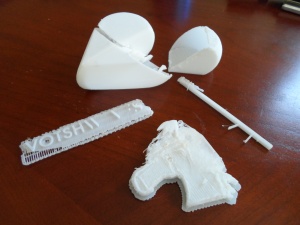Votsh is building machines that animate light and sound to bring meaning to people’s lives. We are using 3D printing to prototype the Votsh Waves devices.
I have been using a Makerbot Replicator 2 at the San Jose Techshop. I found the Up! Mini 3D printer at the Maker Faire 2014 Bay Area last month. They announced a price drop to $599. Bought it through Amazon, now sold out. It arrived on Friday and I printed my first piece on Friday night. The unit comes fully assembled. I just needed to read the manual and get going. The results were not so pleasant, although I am now the coolest kid on the block, well at least for the moment.
- Up Mini comes with its own software. It runs on Windows and Mac. It takes STL files as input. It does the slicing and dicing. It sends the files over USB to the printer. The printer does not need to be connected once the transfer completes. The software lets you import multiple STL files and print them as one job. The software lets you manipulate the objects (rotate, scale, move). The software lets you calibrate the print platen height to the extruder head.
- I used the software to import an STL file, positioned it, calibrated the platen height, configured the job to print in “fine” mode, clicked print… and the software crashed. Not a good out-of-box experience.
- Support comes from a Web-based forum. It looks like pp3dp people participate in the forum. Don’t expect immediate answers – think a day instead of an hour. Also, the forum requires approval before you can post a question and that took me an extra day.
- I read on the forums that the Mac software has crashing problems. The work around was to save the project before printing. I did that and was able to print.
- The printer is basically blind and dumb. The on-off switch has a status LED that blinks depending on the operation. A speaker signals the start and end of a print job. Anything else is not available: no way to pause a print, no way to stop a print. The software allows you to add print pauses based on time during the print.
- The printer supports ABS and PLA. It comes with a spool of white ABS. I was not able to get anything to print correctly at first. The print head acted strangely – printing in the air, printing globs of plastic in random patches. I thought maybe I had a bad unit.
- The printer comes with 3 sheets of pc board like material with a grid of holes drilled through. These load into the print platen and the extruder head prints onto the pc board. The boards holes fill up with plastic and that forms the stickiness your objects need to grip to the platen. The system is kind of silly as trying to retrieve printed objects from the board doesn’t work for small objects. I found the small objects crumbled as I used the provided spatula to remove them from the board after printing. My solution was to buy a roll of blue printers tape and cover the pc board. That even works for ABS when the pc board is heated by the printer.
- Temperature controls are limited by the software. It chooses for you PLA at 220 C and ABS at 255 C. For ABS it turns-on the bed’s heater. This is supposedly to encourage you to only use plastic purchased from pp3dp. There are hacks to get around this and set your own temperature, for example http://thevariableconstant.blogspot.com/2014/02/peeling-up-up-mini-temperature-hack.html
- The software ignores the “No Raft” option for one of my print jobs. It doesn’t print the full raft, instead it prints a mini single-strand of waves around the base of my object. Still have not found a way to have it only print the object.
- I printed from a spool of MakerBot PLA TrueBlue I had purchased and had a really bad experience. The extruder head jammed on feeding the PLA. It was so bad that I had to disassemble the head, remove the PLA, and assemble it again. I believe it is the fault of the PLA and not the printer as I have had problems with this spool on a MakerBot Replicator 2 before.
- The printer head is held onto the printer by 3 magnets. I have seen the head hit the object is was printing so hard that the head temporarily came apart from 2 of the 3 magnets. The printer continued to move the head and it reattached. Maybe that’s the design, but it was shocking to see this happen.
So far I have printed only 1 thing successfully, http://www.thingiverse.com/thing:44579, of the 8 I tried. I feel like I’m at the middle of a long Up Mini learning curve.
-Frank Cohen

